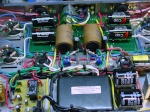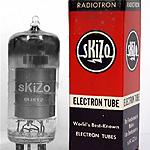On an original build amp. Just to see if there is a difference in the sound? Any personal experiences from doing this? Thanks!
+4
Jim McShane
zx
arledgsc
n3ikq
8 posters
Any danger changing feedback line from 16 ohm to 8 ohm tap?

n3ikq- Posts : 26
Join date : 2014-10-16

arledgsc- Posts : 503
Join date : 2012-11-30
A generic answer is you get less negative feedback using the 8 ohm tap. This means more gain and wider frequency response at the expense of an increase in distortion, less damping factor, and less stability to oscillation. My experience comes from tube guitar amps so never experimented with Dynaco type amps.

zx- Posts : 205
Join date : 2011-08-05
Today most like there Speakers to be in the Feedback loop......so if you not runing 16ohm speakers... I have none.......i run all my tube amps feedback on the 4 or 8ohm taps....i work on amps an people like VTL...only put a so called 5ohm tap on there amps stock outputs .....but on some of there output trans there are 2-4ohm wire inside the amps......
myself an others think it sounds better on the lower taps ....
try it with your speakers....tell us what you think...have fun with tubes......................
Thanks for the site Bob..................
myself an others think it sounds better on the lower taps ....
try it with your speakers....tell us what you think...have fun with tubes......................
Thanks for the site Bob..................

Jim McShane- Posts : 237
Join date : 2011-10-19
Location : South Suburban Chicago
arledgsc wrote:A generic answer is you get less negative feedback using the 8 ohm tap. This means more gain and wider frequency response at the expense of an increase in distortion, less damping factor, and less stability to oscillation. My experience comes from tube guitar amps so never experimented with Dynaco type amps.
WIDER frequency response?? How does that occur?
In an amp using loop negative feedback from the OPT secondary back to the input tube cathode the greater the feedback (overall, across all audio frequencies - not frequency specific) the wider the frequency response will be. This is true as long as the open loop gain is greater than the closed loop gain.
For a nice explanation check out Randall Aiken's site: Aiken's Page On NFB

bluerondo- Posts : 27
Join date : 2014-09-21
Location : Irvine, CA
What a great website of technical information. Thanks for that post.

Bob Latino- Admin
- Posts : 3276
Join date : 2008-11-26
Location : Massachusetts
Jim is correct here .. as you increase the amount of feedback the frequency response gets a little wider and flatter. On all the VTA amp kits we use a 7.5K resistor taken off the 16 ohm tap. Both Roy and I agree here that (at least in an amp driven by a VTA driver board) that a 7.5K resistor is "about right" for a VTA board driven amp. You CAN reduce the value somewhat to maybe about 3.5K and get more feedback. If you go any lower than that, then the character of the amp's sound changes. I have gone as low as 2.2K on the feedback resistor and IMHO that was too low and the amp took on a "harder" sound that was less "tube like". If you go any higher than about 10K (12K - 15K) these amps start to get a little "sloppy" in the bass regions.
I know some kit builders that have just disconnected the feedback line and told me how great the amp sounds. Well - with NO feedback the gain of the amp goes up and maybe it now sounds LOUDER and you think it sounds better but three things happen. Frequency response is now not as wideband as it once was, distortion goes up a little AND the amp now loses some of its ability to drive certain speakers that present a complex load to the amp.
With the 7.5K feedback resistor on VTA boarded amps, these amps will drive just about ANY speaker including full range electrostatic speakers and planar magnetic speakers at full power without any issues.
Bob
I know some kit builders that have just disconnected the feedback line and told me how great the amp sounds. Well - with NO feedback the gain of the amp goes up and maybe it now sounds LOUDER and you think it sounds better but three things happen. Frequency response is now not as wideband as it once was, distortion goes up a little AND the amp now loses some of its ability to drive certain speakers that present a complex load to the amp.
With the 7.5K feedback resistor on VTA boarded amps, these amps will drive just about ANY speaker including full range electrostatic speakers and planar magnetic speakers at full power without any issues.
Bob

sKiZo- Posts : 1530
Join date : 2013-04-01
Location : Michigan USA
Hmmmmmmm ... might be fun replacing the 7.5K fixed value with a 10k pot so you can fine tune the feedback to a particular build and speaker ...

arledgsc- Posts : 503
Join date : 2012-11-30
Jim McShane wrote: WIDER frequency response?? How does that occur?
My mistake. Increasing negative feedback tends to flatten and extend frequency response. Thanks, Scott

n3ikq- Posts : 26
Join date : 2014-10-16
Thanks everyone. Great info.

DynakitParts- Posts : 215
Join date : 2008-11-30
- Post n°10
 8 ohm or 16 ohm NFB tap
8 ohm or 16 ohm NFB tap
Hi,
Interesting fact...The original ST-70 Series II produced by Sound Valves used the 8 ohm tap for the negative feed back as opposed to the 16 ohm tap.
At some point (later on) Panor began producing these units & may have retained this same 8 ohm NFB connection. Could there be some benefit?
Kevin@ Dynakit
Interesting fact...The original ST-70 Series II produced by Sound Valves used the 8 ohm tap for the negative feed back as opposed to the 16 ohm tap.
At some point (later on) Panor began producing these units & may have retained this same 8 ohm NFB connection. Could there be some benefit?
Kevin@ Dynakit

zx- Posts : 205
Join date : 2011-08-05
Could there be some benefit........how will you know less you go?
For me an the people that i know that are into tubes...it all about the sound!
Everone can say what thay well...............But if anyone can move one wire an put the Speakers Drivers in the feedback loop an not hear a diff....why have tubeamp??
I gess your into the look. of tubes..
if thats the case go to ratshak an get a $10. 12V tranfourmer..... lites up some tubes by just runing the heaters.....eveyone well think you have tubeamps eveywhere.....right...
Feedback is one wire an most Dynaco have 3 taps!............gofig
Have fun with tubes........................An get good Sound..Maybe
Thanks for the site Bob...................
For me an the people that i know that are into tubes...it all about the sound!
Everone can say what thay well...............But if anyone can move one wire an put the Speakers Drivers in the feedback loop an not hear a diff....why have tubeamp??
I gess your into the look. of tubes..
if thats the case go to ratshak an get a $10. 12V tranfourmer..... lites up some tubes by just runing the heaters.....eveyone well think you have tubeamps eveywhere.....right...
Feedback is one wire an most Dynaco have 3 taps!............gofig
Have fun with tubes........................An get good Sound..Maybe
Thanks for the site Bob...................

DynakitParts- Posts : 215
Join date : 2008-11-30
- Post n°12
 8 ohm or 16 ohm NFB tap
8 ohm or 16 ohm NFB tap
ZX...
I did not appreciate your comments directed to me personally. This Forum is for all members to share information and post questions...I gess you know it all...
Kevin @ Dynakit
I did not appreciate your comments directed to me personally. This Forum is for all members to share information and post questions...I gess you know it all...
Kevin @ Dynakit

zx- Posts : 205
Join date : 2011-08-05
Ok... i well keep how you feel in mind.......thanks
Thanks for the site Bob......................
Thanks for the site Bob......................

arledgsc- Posts : 503
Join date : 2012-11-30
Which transformer tap to use for NFB? I asked this question to a veteran tube guy once and he stated use the tap that is required for the amount of feedback voltage needed. But for lowest distortion should you use the same tap as the speakers? He stated the output transformer windings are tightly coupled so deviations caused by the speaker on say the 8 ohm tap will be reflected as well on the 4 and 16 ohm taps - only at lower and higher voltages. This NFB voltage will drop slightly if the NFB tap is under load with a speaker but generally not by much.
